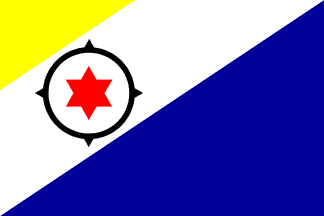 (2:3)
(2:3)image by Mark Sensen, 14 December 2003

Last modified: 2006-11-25 by dov gutterman
Keywords: netherlands antilles | nederlandse antillen | dutch realm | netherlands | antilles | bonaire |
Links: FOTW homepage |
search |
disclaimer and copyright |
write us |
mirrors
 (2:3)
(2:3)
image by Mark Sensen, 14 December 2003
See also:
Divided from lower hoist to upper fly with lower portion dark
blue (or blueish purple) and upper half divided with a yellow top
portion starting 1/3 down from top hoist and paralleling the
diagonal. The portion between the blue and the yellow is white
with a red six pointed star circled with a blue line that has
dots (? la compass rose) at four primary directions.
William M. Grimes-Wyatt, 8 April 1996
From <www.infobonaire.com/html/history.html>:
"Our flag contains the colors red, white and blue,
representing our respect for the Dutch Kingdom's tricolor.
At the upper end of our flag we have a yellow triangle, which is
the bright light of our sun and also the beauty of our nature.
Most Bonairean flowers are yellow like Kibrahacha, Kelki
gel, Brasilia, Hobada, Cucu, Sente-bibu, Angelo Watapana and many
others.
Below we have a blue triangle, and that is the color of our
beautiful sea. You can see the triangle as a gigantic wave
or a high mountain to remind us of the great heights we have
climbed.
In the middle of our flag is the white area symbolizing peace,
liberty and tranquility.
In this white area we have a black ring with four points of the
navigation-compass. That compass is what our indisputable
navigators have used to travel all over the world.
In that ring there is a six-pointed red star. The color
symbolizes blood, as the fighting and surviving spirit of the six
traditional regions, which form together the people of
Bonaire."
Erki Kurrikoff, 5 Febuary 2002
According to Album 2000 [pay00]
- Bonaire - Proportions 2:3, divided diagonally from lower hoist
to upper fly, the lower part blue, the upper part divided
diagonally yellow and white, parallel to the former, starting at
a point 1/2.4th of the flag height under the upper hoist. At the
white stripe a red six pointed star in a black compass rose. The
centre of these located horizontally at the line 1/2.4th of the
flag height right of the upper hoist, vertically half way the
points of contact of this line and the two diagonal lines. The
height of the star is equal to one quarter of the flag height.
The radius of the outer circle of the compass rose is equal to
the length of a side of one of the two triangles forming the
star. The radius of the inner circle of the compass rose is equal
to the height of one of the two triangles forming the star. The
diameter of the imaginary circle trough the outer points of the
compass rose is half the flag height. The little triangles at the
points are formed by tangent lines to the imaginary circle
circumscribing the star. Adopted by Island-Order of 11 December
1981.
Mark Sensen, 14 December 2003
As far as I can see there are no officially recommended or
defined colours for the flag of Bonaire. If it of any
use however, the Album des Pavillons [pay00]
gives red 186C, blue 286C and yellow 129C, while the Flag
Institute of Great Britain gives red 032C, blue 286C and yellow
109C.
Christopher Southworth, 1 September 2004
From "amigoe site" I realized there were a
referendum on the Bonaire status held on September 10, 2004. It
actually was a consultation in order to know what are the wishes
on political status of the Bonaireans. According the results,
Bonaireans chose, out of for options, the one that states that
Banaire should became a part of the Kingdom of the Netherlands...
Here you are some pages:
- <www.amigoe.com/article_9116.shtml>
(opinion).
- <www.amigoe.com/artikel>
(referendum results).
Juan Manuel Gabino Villascán, 24 November 2004
Minister Nicolai of Kingdomrelations reached a historic
agreement with Curaçao and Sint Maarten. The islands will become
separate countries, like Aruba. That means that the
co-operation between the Netherlands and the Netherlands
Antilles, as agreed by the "Koninkrijksstatuut" of
1954, will end. It is agreed that there will be a common court of
justice of the Netherlands, Curaçao and Sint Maarten. There are
also agreements on policing and prosecution. The Netherlands will
take care of the debts of the Netherlands Antilles, totalling 2,5
billion Euros. The Netherlands Antilles will cease to exist on 1
July 2007. Bonaire, Saba and Sint Eustatius will become Dutch
municipalities. Aruba is a separate entity since 1986.
No info about change of flags. The currency is also unclear,
although it seems that Aruba might be forced to enter the
Euro-zone(!)
Source: <www.nos.nl>
reported by Stefan Lambrechts.
Jarig Bakker, 3 November 2007
Two flags at
<www.ajcampbell.net/bonaire/Completed_Bonaire/Flags.jpg>
(defunct). The photograher named them at
<www.ajcampbell.net/bonaire/bonaire_picts.html> (defunct)
as: "A shot of the Harbour Village Flag and the Flag of
Bonaire(?) "
It is a Bonaire flag...but is there a place called "Harbour
Village" there ?
Dov Gutterman, 4 January 2003
Yes, there is a place. According to the description found:
"Bonaire's most luxurious resort. Features a highly rated
spa, as well as one of the only two marinas." Website: <www.harbourvillage.com>.
The flag is white white the logo of that place.
Pascal Vagnat, 4 January 2003